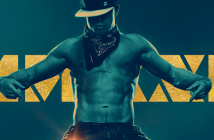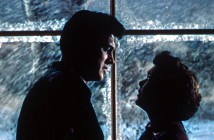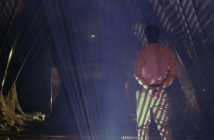Editor’s Notes: The following review is part of our coverage for TIFF’s Dreaming in Technicolor. For more information on this TIFF film series visit http://tiff.net and follow TIFF on Twitter at @TIFF_NET.
The character of Robin Hood has been showing up in films as far back as 1912, either in films specifically devoted to him or in the occasional adaptation of Sir Walter Scott’s Ivanhoe and has been played by no less than Douglas Fairbanks, Frank Sinatra, Kevin Costner, Cary Elwes and Russell Crowe but the best incarnation of the character was embodied by the great Errol Flynn in 1938’s The Adventures of Robin Hood. Flynn’s ability to jump between carefree to dutiful to romantic all while exuding endless amounts of charm is unmatched (except perhaps by Fairbanks, who preceded Flynn in the roll 16 years prior and may have served as a template for Flynn).
Flynn’s ability to jump between carefree to dutiful to romantic all while exuding endless amounts of charm is unmatched.
The story is well known by now: Sir Robin of Loxley is branded an outlaw in 1190’s England because he refuses to swear fealty to King Richard’s younger brother John (who is apparently a distant relative of mine) while Richard is off fighting in the Third Crusades and ends up getting kidnapped and ransomed. Robin gathers a group of men who rob the rich and give to the poor and overtaxed peasants of the Nottingham region of England. He meets and falls in love with Lady Marion (the beautiful Olivia de Havilland, who just celebrated her 99th birthday on July 1), King Richard’s ward (though she is not part of the actual Robin Hood legend. Their love story was based on a French ballad that had nothing to do with Robin Hood except the characters were named Robin and Marion. She is now inexorably linked to the legend because of this film). He eventually wins her over while he attempts to thwart Prince John (the always magnificent Claude Raines) and his accomplices Sir Guy of Gisbourne (Basil Rathbone, who would later become the quintessential Sherlock Holmes, sorry Benedict Cumberbatch) and the Sherriff of Nottingham (Melville Cooper) from claiming the thrown for himself. Joining Robin are Little John (Alan Hale, later the Skipper on Giligan’s Island), Will Scarlett (Patrick Knowles), Friar Tuck (the brilliant character actor Eugene Pallette) and others.
 The script by Norman Reilly Raine and Seton I. Miller, based on various legends, wastes no time getting us into the action. From the moment we first see Robin shooting a deer on the King’s land, we’re drawn into the time and are immediately interested in Robin. Not long into the film we get the first major action sequence, in which Robin has to fight his way out of Castle Nottingham. Raine and Miller do a fantastic job of setting up most of the characters in that banquet sequence, introducing us to Prince John, Marion, Guy of Gisbourne and the Sheriff, then in a couple of scenes directly after we get to Robin’s men. There is a wonderful economy to the script that helps the film move at a fairly brisk pace. They waste no scenes and actually spend time developing their characters, giving them nuance and purpose instead of just perfunctory good and evil personalities designed to simply set up the next action sequence. They also took great care in the balance of tone in their screenplay. Many swashbucklers of the day were primarily concerned with long action sequences without much emphasis on much else, but Raine and Miller fill their time between action sequences with a well-developed romance (Robin actually has to convince Marion that he’s the good guy then she eventually falls in love with him instead of the typical scenario wherein they are both in a love that will never die from the moment they lock eyes) and a lot of comedy. Swashbucklers always had a little comic relief, but Raine and Miller weave the comedy throughout the film, injecting it into the action sequences as well as the quieter moments. This balancing of tones helped set a template for swashbucklers to be sure, but also many modern action films in general.
The script by Norman Reilly Raine and Seton I. Miller, based on various legends, wastes no time getting us into the action. From the moment we first see Robin shooting a deer on the King’s land, we’re drawn into the time and are immediately interested in Robin. Not long into the film we get the first major action sequence, in which Robin has to fight his way out of Castle Nottingham. Raine and Miller do a fantastic job of setting up most of the characters in that banquet sequence, introducing us to Prince John, Marion, Guy of Gisbourne and the Sheriff, then in a couple of scenes directly after we get to Robin’s men. There is a wonderful economy to the script that helps the film move at a fairly brisk pace. They waste no scenes and actually spend time developing their characters, giving them nuance and purpose instead of just perfunctory good and evil personalities designed to simply set up the next action sequence. They also took great care in the balance of tone in their screenplay. Many swashbucklers of the day were primarily concerned with long action sequences without much emphasis on much else, but Raine and Miller fill their time between action sequences with a well-developed romance (Robin actually has to convince Marion that he’s the good guy then she eventually falls in love with him instead of the typical scenario wherein they are both in a love that will never die from the moment they lock eyes) and a lot of comedy. Swashbucklers always had a little comic relief, but Raine and Miller weave the comedy throughout the film, injecting it into the action sequences as well as the quieter moments. This balancing of tones helped set a template for swashbucklers to be sure, but also many modern action films in general.
This balancing of tones helped set a template for swashbucklers to be sure, but also many modern action films in general.
The direction is also a stand-out, which is interesting because the film was originally started by the criminally under-recognized William Keighley and finished by Michael Curtiz, who is still remembered today for Casablanca (the greatest Hollywood movie ever made) but is still under-appreciated. Keighley was fired from the picture when Warner Bros. studio heads felt the action sequences they saw in the dailys were dull. They pulled Keighley from the picture and put Curtiz on, known at the time as a good studio director and the man responsible for directing Flynn in Captain Blood, another great swashbuckler. Some of Keighley’s location footage was used in the final picture and it creates an interesting contrast. The directors had distinctly different styles and they are evident throughout the picture. Keighley was a very straightforward director, while Curtiz was much flashier, using elegant tracking shots and pushing in on characters during emotional moments. The differences in style don’t clash, they enhance each other in a way that seldom happens when two vastly different directors work on a picture. Keighley’s medium-long shots punctuate many of the early dramatic scenes and Curtiz’s flashy camera moves are more prevalent in the later ones when the emotions are in high gear. It all works to intensify those scenes in counter to the exciting (if a bit dated) action sequences.
I would be remiss if I did not mention the stunning 3-strip Technicolor work in this picture. Cinematographers Tony Gaudio and Sol Polito had to use all 11 Technicolor cameras in existence at the time to capture all of the action in the film. The result was gorgeous hues and a vivid color palate. They somehow managed to avoid a lot of the over-saturation that was common in early 3-strip Technicolor and produced one of the best looking early color films.
The thing that most impresses me about the film is that it has managed to avoid a lot of the down-playing that many older films receive from later generations of viewers. Often a film with a stellar reputation, like Citizen Kane, will be looked upon as antique and people who have grown up on endless imitations will not understand what makes an older film great. The Adventures of Robin Hood is just so entertaining that while the action sequences are, as I stated, a bit dated in comparison to the advances in screen fighting, the emotion behind the fights still work to carry an audience through so that when Robin and Gisbourne finally duel, the emotional impact makes the fight enthralling even if the sword fighting could have been a bit better. This is why The Adventures of Robin Hood stands as not just one of the great swashbuckler films but one of the greatest films of all time.
The Adventures of Robin Hood stands as not just one of the great swashbuckler films but one of the greatest films of all time.



